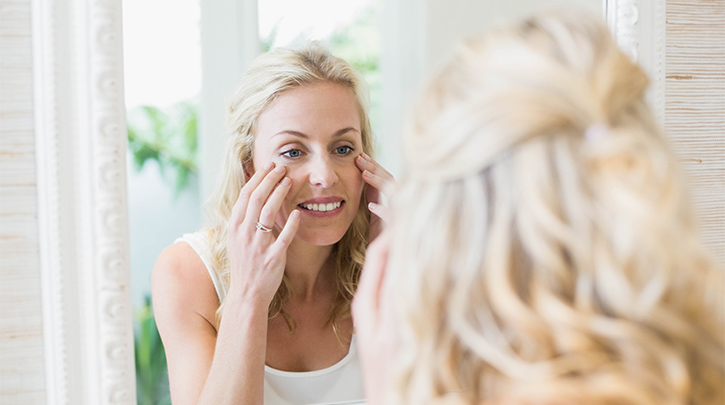
- Global
Get non-surgical solutions for today's top aesthetic concerns with Venus Treatments. Join thousands of satisfied patients worldwide!
- Loading...
- All Regions
Get non-surgical solutions for today's top aesthetic concerns with Venus Treatments. Join thousands of satisfied patients worldwide!

The effects of extrinsic (external) aging are generally well known and garner a lot of attention. We’re all told to wear our SPF year-round, covet skin care containing antioxidants to fend off damaging free radicals in air pollution, and are even cautious of the effects of a defective fluorescent light on skin health. Diet and exercise are also common tips for boosting your anti-aging beauty regimen, but what about other intrinsic (internal) aging factors?
Did you know that your endocrine system, as a producer and regulator of hormones, is inextricably linked to how fast your skin will age? Here’s how it’s all linked and why you’ll need to consider alternative anti-aging tactics to fend off the effects of hormones on skin health.
Intrinsic skin aging refers to aging factors that occur within the body, which is usually linked to your biological clock. There are a few components that make up intrinsic aging, but hormones play a major role. As the source and regulator of hormones, your endocrine system is responsible for helping to keep skin looking plump and firm. Over time, the endocrine system naturally weakens and hormone levels drop. However, the balance between hormone levels and skin health is much more complex and the results that show up in your complexion will depend on what hormones are rising or declining. An increase in acne breakouts, skin dehydration, fine lines and wrinkles, and a flushing in skin tone are all a natural part of intrinsic skin aging.
Higher levels of testosterone are the reason men’s skin often resists fine lines and decreased elasticity until much later in life (though it’s no match for UV damage). As with most hormones, testosterone levels will eventually decline with age. When testosterone levels are healthy, the hormone contributes to natural skin moisture via increased oil production and supports optimal collagen production levels for strong, smooth skin. As testosterone levels fall, skin loses elasticity and starts to form thicker folds and deeper wrinkles.
Estrogen levels play a major role in female skin health. While estrogen is present in men, average levels tend to be much higher in women. Converted from androgens using key enzymes, estrogen actually refers to three hormones: estradiol, which are the most abundant over a lifetime; estriols, which are more common during pregnancy; and estrones, which are most common during menopause. Together, estrogens impact skin thickness, smoothness, and hydration. Estrogens help maintain the structure and moisture content of skin, supporting hyaluronic acid levels and collagen production for a plumper, more radiant appearance. However, as estrogen levels rise or fall, skin health may also fall out of balance. A decline in estrogen can lead to an increase in inflammation, triggering skin conditions like rosacea. As collagen production declines, skin thins, elasticity dwindles, and wrinkles form. The delivery of healthy blood vessels to the skin, which support healing and skin cell renewal, also declines alongside lower estrogen levels, leading to paler, thinner skin. In comparison, higher levels of estrogen can increase the risk of pigmentation, particularly to areas more commonly exposed to sunlight. Wholly hormone-related, this form of hyperpigmentation is called melasma and often occurs during pregnancy.
Androgens are a type of male hormone, but women have it too. Higher levels of androgen can cause overstimulation of the oil glands, leading to excess sebum. As skin cells are ready to shed, they become stickier, leading to a buildup in hair follicles that leads to pimples and inflammation. In women, there is a fine balance between estrogens and androgens. Because that balance generally becomes skewed with age and the onset of menopause, women tend to experience greater rates of adult acne. A temporary imbalance during menstruation is also common.
Thyroid hormones refer to triiodothyronine (T3) and thyroxine (T4), both of which rely on a specific balance for optimal skin health. If too many of these hormones are present in the endocrine system, skin can appear flushed and feel sweaty and warm. If too few are present, hydration of the lipid barrier plummets and skin becomes dry and coarse, emphasizing fine lines and increasing the appearance of deep-set wrinkles.
While the only way to halt or even potentially reverse the effects of fluctuating hormone levels on skin is hormone therapy, there are ways to kickstart skin’s natural healing cycles and boost skin health without altering hormone levels.
For those experiencing late-onset acne, a dermatologist may recommend a topical retinoid. If using a topical, only apply as much as directed—using more isn’t going to achieve better results or a clearer complexion faster. In fact, applying too much could dry out skin, causing further clogging of pores and even more breakouts. Alternatively, you may be an ideal candidate for Intense Pulsed Light (IPL) acne treatments. These treatments utilize IPL with a red light and blue light to deliver energy and heat deep below the skin’s surface. The two lights work together to stimulate skin’s natural healing cycle while soothing redness and inflammation and destroying further acne-causing bacteria in the process. The result is a one-two punch to current and future breakouts, resulting in clearer, healthier-looking skin.
For a collagen boost or to tighten skin, anti-aging skin care products containing vitamins A or C or retinoids may help to erase pigmentation and brighten skin while prompting natural skin cell renewal. Skin tightening treatments utilizing radio frequency (RF) energy, particularly with a device like Venus Legacy™ that features VariPulse™ technology to deliver energy deeper below the skin’s surface, may better target and boost skin’s natural collagen and elastin production cycles. The result is smoother, firmer skin with the restoration of skin elasticity and an overall stronger structure via increased collagen production.
Finally, exfoliating, when performed correctly, is key to boosting skin cell renewal while preventing any potential buildup of excess sebum and dead skin. Aim to exfoliate two to three times per week and follow up with an appropriate moisturizer to boost lipid barrier health and restore skin hydration. To further reduce the appearance of pigmentation or target acne scars, however, standard exfoliants won’t cut it. Instead, consider customized RF skin resurfacing treatments to target and restore skin tone and texture. By creating tiny micro-dermal wounds on the skin’s surface that stimulate skin’s natural healing cycle via RF energy, these treatments help to reset and restore smoother, younger-looking skin.
Interested in trying a customized acne, wrinkle reduction, or skin resurfacing treatment plan to improve the look of your skin? Use the search field below to contact a certified treatment provider near you today to learn how you can get started.
Find a certified Venus Treatments provider near you today who specializes in today’s top aesthetic medical solutions.



Search below to find a provider near you and to learn about our non-surgical aesthetic treatments with ARTAS®, NeoGraft®, Venus Bliss™, Venus Blilss MAX™, Venus Versa™, Venus Legacy™ Venus Versa™ Pro, Venus Velocity™, Venus Viva™ MD, and Venus Glow™.
For more information call: (888) 907-0115 // [email protected] // 235 Yorkland Blvd., Suite 900, Toronto, ON, M2J 4Y8 Canada
REGULATORY CLEARANCES [ More ]
Venus Bliss™ is cleared by the FDA and licensed by Health Canada for non-invasive lipolysis of the abdomen and flanks in individuals with a Body Mass Index (BMI) of 30 or less, with the diode laser applicators. The (MP)2 applicator is cleared by the FDA for temporary reduction in the appearance of cellulite, and licensed by Health Canada for temporary increase of skin tightening, temporary circumferential reduction, and temporary cellulite reduction. Venus Bliss™ has CE Mark as a non-invasive medical aesthetic device enabling a comprehensive approach leading to body contouring, addressing fat reduction, skin tightening, circumference reduction, and cellulite reduction.
Venus Versa™ is cleared by the FDA, licensed by Health Canada, and has CE Mark as a multi-application device intended to be used in aesthetic and cosmetic procedures. The SR515 and SR580 applicators are cleared by the FDA, licensed by Health Canada, and have CE Mark for the treatment of benign pigmented epidermal and cutaneous lesions and treatment of benign cutaneous vascular lesions. The HR650/HR650XL and HR690/HR690XL applicators are cleared by the FDA, licensed by Health Canada, and have CE Mark for the removal of unwanted hair and to effect stable long-term or permanent hair reduction for Fitzpatrick skin types I-IV. The AC Dual applicator is cleared by the FDA, licensed by Health Canada, and has CE Mark for the treatment of acne vulgaris. The DiamondPolar™ and OctiPolar™ applicators on the Venus Versa™ system are cleared by the FDA for non-invasive treatment of moderate to severe facial wrinkles and rhytides on females with Fitzpatrick skin types I-IV. The DiamondPolar™ applicator is licensed by Health Canada and has CE Mark for non-invasive treatment of moderate to severe facial wrinkles and rhytides on females with Fitzpatrick skin types I-IV. The OctiPolar™ applicator on the Venus Versa™ system is licensed by Health Canada and has CE Mark for temporary body contouring via skin tightening, circumferential reduction, and cellulite reduction. The NanoFractional RF™ (Viva) applicator is cleared by the FDA, licensed by Health Canada, and has CE Mark for dermatological procedures requiring ablation and resurfacing of the skin.
NeoGraft® is cleared by the FDA, licensed by Health Canada and has CE Mark with indication for use in suction-assisted follicular extraction and re-implantation. It is an auto-graft system and can be used on both male and female patients.
ARTAS iX™ is cleared by the FDA, licensed by Health Canada and has CE Mark with indication for use for harvesting hair follicles from the scalp in men diagnosed with androgenic alopecia (male pattern hair loss) who have black or brown straight hair. ARTAS iX™ is intended to assist physicians in identifying and extracting hair follicular units from the scalp during hair transplantation; creating recipient sites; and implanting harvested hair follicles.
Venus Legacy™ is cleared by the FDA for the non-invasive treatment of moderate to severe facial wrinkles and rhytides in females with Fitzpatrick skin types I-IV with the OctiPolar™ and DiamondPolar™ applicators, and temporary reduction in the appearance of cellulite with the 4D Body (LB2) and 4D Face (LF2) applicators. It is licensed by Health Canada and has CE Mark for the temporary increase of skin tightening, temporary circumferential reduction, temporary cellulite reduction, and temporary wrinkle reduction.
Venus Velocity™ is cleared by the FDA, licensed by Health Canada and has CE Mark for hair removal, permanent hair reduction (defined as the long-term stable reduction in the number of hairs re-growing when measured at 6, 9 and 12 months after the completion of a treatment regimen), and the treatment of pseudofolliculitis barbae for all Fitzpatrick skin types.
Venus Fiore™ received regulatory approval in Israel for aesthetic and functional treatment of the vagina, labia and mons pubis. Venus Fiore™ is available for sale in India, Hong Kong, and other selected Asian countries.
Venus Viva™ is cleared by the FDA, licensed by Health Canada, and has CE Mark for dermatological procedures requiring ablation and resurfacing of the skin. The DiamondPolar™ applicator is cleared by the FDA, licensed by Health Canada and has CE Mark for the treatment of moderate to severe wrinkles and rhytides in Fitzpatrick skin types I-IV.
Venus Freeze Plus™ is cleared by the FDA for the non-invasive treatment of moderate to severe facial wrinkles and rhytides in females with Fitzpatrick skin types I-IV. It is licensed by Health Canada for temporary skin tightening, and temporary reduction in the appearance of cellulite on the abdomen and flanks, using the DiamondPolar™ and OctiPolar™ applicators. The DiamondPolar™ applicator on Venus Freeze Plus™ has CE Mark for the non-invasive treatment of moderate to severe facial wrinkles and rhytides, and the increase of skin tightening, temporary circumferential reduction, and cellulite reduction with the OctiPolar™ applicator.
Venus Heal™ is licensed by Health Canada and can be used for the treatment of both acute and chronic disorders of the musculoskeletal system, such as muscle spasms, back pain, and soft tissue injuries, and results in effects such as pain relief, myorelaxation, increase of local blood circulation, and edema reduction. In the U.S., Venus Heal™ is cleared by the FDA for the relief of minor muscle aches and pain, relief of muscle spasm, and temporary improvement of local blood circulation. These indications enable the treatment of certain soft tissue injuries and conditions.
Venus Glow™ is cleared by the FDA as a Class I motorized dermabrasion device. It provides a dermal rejuvenation treatment that works to open up and deep-clean pores. Venus Concept is the exclusive distributor for Venus Glow™.
Venus Epileve™ is licensed by Health Canada and has CE Mark for hair removal, permanent hair reduction (defined as the long-term stable reduction in the number of hairs re-growing when measured at 6, 9 and 12 months after the completion of a treatment regimen), and the treatment of pseudofolliculitis barbae for all Fitzpatrick skin types. Venus Epileve™ is also CE-Marked for hirsutism.
Venus Freeze™ is cleared by the FDA for the non-invasive treatment of moderate to severe facial wrinkles and rhytides in females with Fitzpatrick skin types I-IV. It is licensed by Health Canada for temporary skin tightening, and temporary reduction in the appearance of cellulite on the abdomen and flanks, using the DiamondPolar™ and OctiPolar™ applicators. The DiamondPolar™ applicator on Venus Freeze™ has CE Mark for the non-invasive treatment of moderate to severe facial wrinkles and rhytides, and the increase of skin tightening, temporary circumferential reduction, and cellulite reduction with the OctiPolar™ applicator.
Venus Swan™ is cleared by the FDA for the non-invasive treatment of moderate to severe facial wrinkles and rhytides, and licensed by Health Canada for the non-invasive treatment of cellulite reduction, skin tightening, and temporary reduction in the appearance of stretch marks.
Copyright © 2024 Venus Concept. All rights reserved.
You are entering our website. For other countries/regions and language options, please click the SELECT A DIFFERENT REGION button below.
SELECT A DIFFERENT REGIONAre you looking to get a treatment? Please visit our patient website to learn more.
Click HereUnsure which aesthetic treatment is right for you? Take this quick and easy quiz to discover treatments that suit your needs.
Get Started